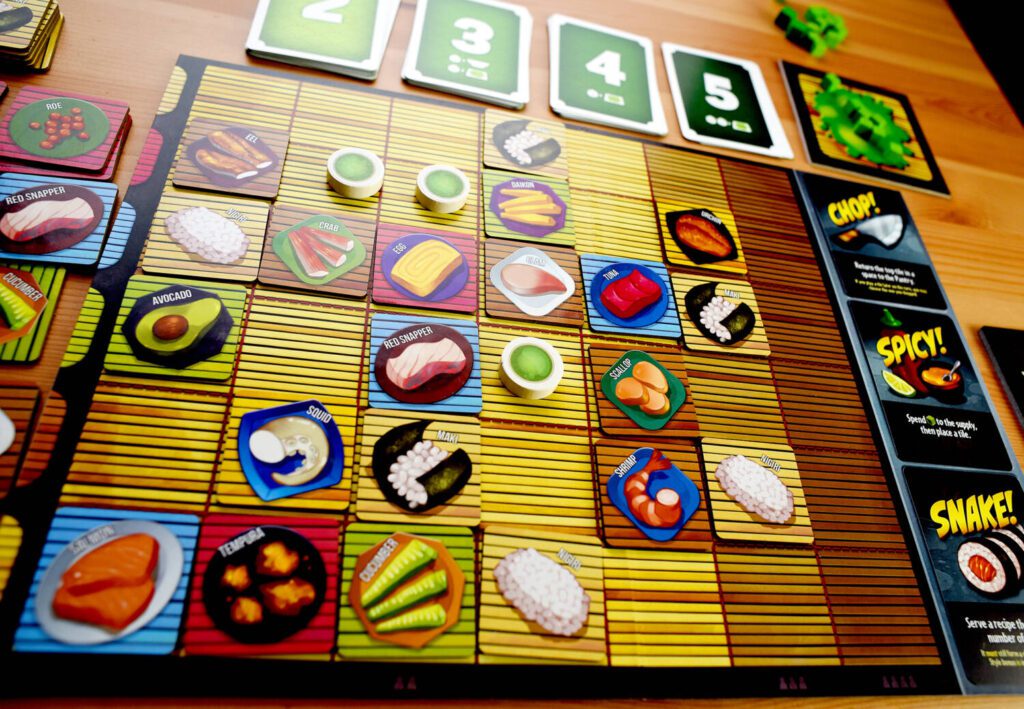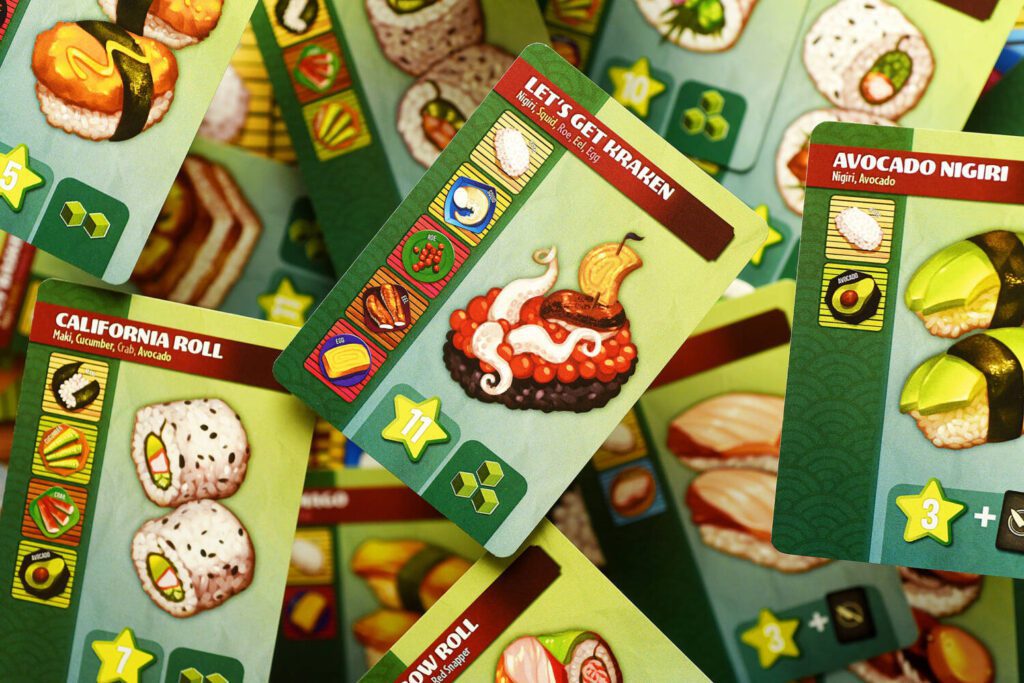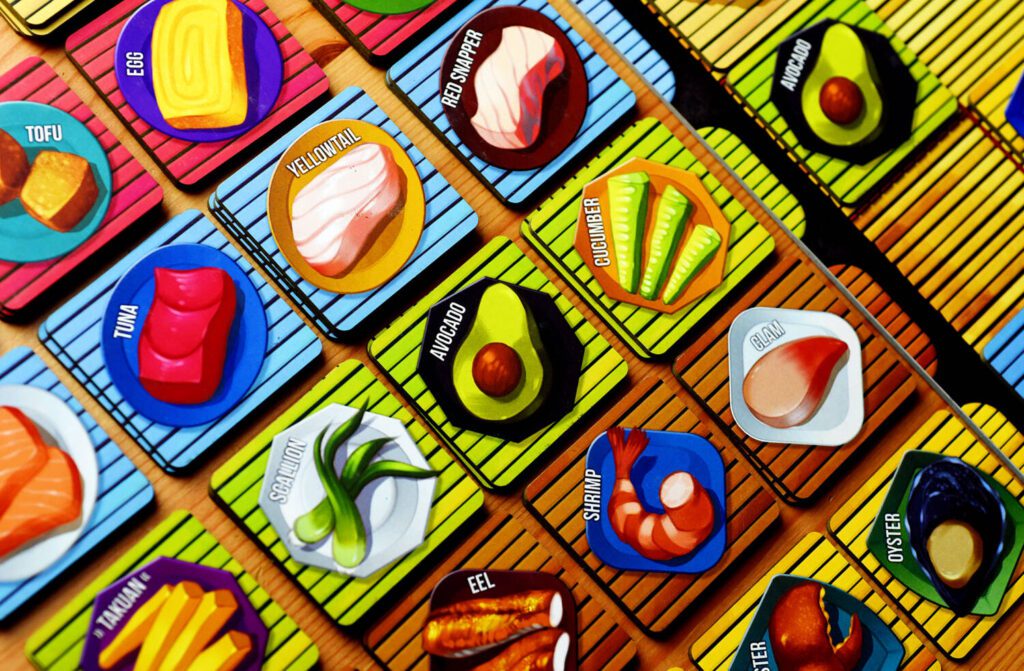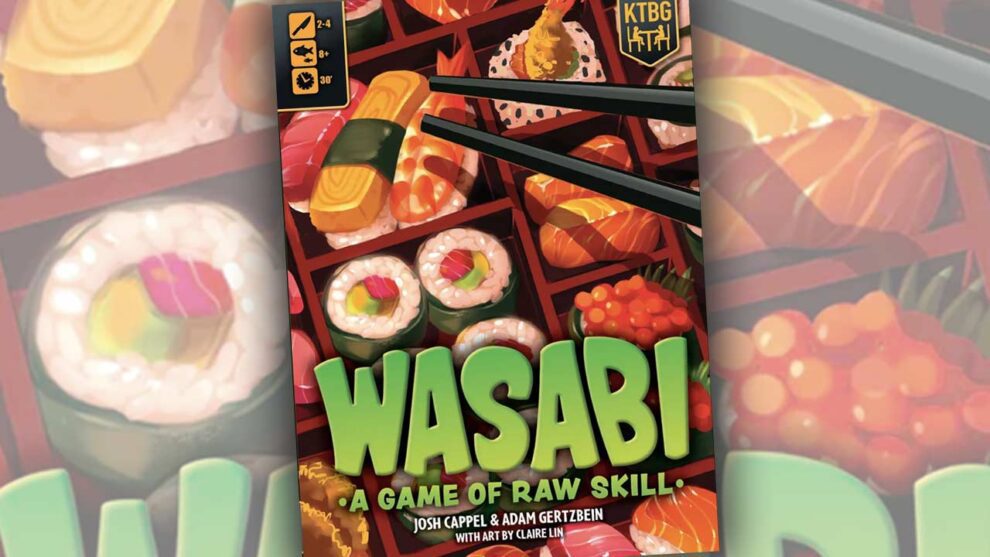Disclosure: Meeple Mountain received a free copy of this product in exchange for an honest, unbiased review. This review is not intended to be an endorsement.
“Good games get reprinted.”
Those four words represent the trend the game industry has been following for the past few years. We’ve witnessed a remake of Reiner Knizia board games within the voting age bracket, such as Ra, Modern Art, Amun-Re, amongst others. In Essen Spiel 2023, a reprint of El Grande was spotted, a 1995 board game that probably doesn’t know what an iPhone is. Even as I am typing out this sentence, my review copies of Robo Rally and Acquire from Renegade Games are sitting in my game bag. Both games are almost old enough to collect a pension check.
These games have become pillars of the industry, inspiring generations of game designers. So it was surprising when it was announced that Wasabi would be reprinted. While not a bad game, Wasabi didn’t exactly set the world on fire when it was first released in 2008. Many players felt it was too random, with little ability to develop long-term strategies. Wasabi’s contribution to the industry did show a market for food-centered themes, which was unheard at the time. Sushi Go later solidified that yes, board games focused on food can work and work extremely well.
Of course, this reprint inevitably leads to some questions. Questions like, will there be changes? Are these changes an improvement? Was this reprint even necessary? Before I answer those, I have to make a few disclosures.

Maki Madness
First, this is a prototype, meaning that the rules might change in the finished product. Second, this is a full-blown review. I don’t do Kickstarter previews, and the publisher was fine with me going into critic mode here.
With that said, what are we doing here? Everyone is a sushi chef trying to score points by completing recipes by lining up and placing ingredients on a central community board. I’m sure the health inspectors are thrilled about this setup.
Speaking of setup, you start with a hand of recipe cards of various lengths and an empty bowl. At the center of the table is an empty grid, a pantry full of ingredients, three face up action cards, and an empty wasabi pile.
Your turn is a two-step process. The first step is to simply choose any ingredient from the pantry and put it in an empty space on the grid. When placing your tile, you may also play one or two Action cards from your hand. These cards let you break the rules, for example, by removing an existing tile or paying a wasabi token to place an additional tile. Your hand size limit is two Action cards, so you can use both cards on the same turn.
After you place a tile, the next step is to either Serve or Prep. Serving is completing one or more recipes, and each recipe wants particular ingredients in a straight line on the grid. The order of the ingredients doesn’t matter, but you do score additional points via wasabi cubes if you do so in the exact order. This is known as “serving with style” and each wasabi cube is worth one point. A 2-length recipe doesn’t give you wasabi cubes, but it does give you the opportunity to take an Action card. An important note is that you cannot complete a recipe if you didn’t contribute to the line of ingredients on the turn you claimed it via tile placement or Action cards. This prevents people from randomly claiming lines of ingredients for their recipes.

Clam Conquest
After scoring the completed sushi recipe cards, players draw back up to a hand limit of 3. An interesting part of this process is that the length of the recipes you choose also determines how many wasabi cubes are added. For example, when taking a 5-length recipe, 2 wasabi cubes get added to the central wasabi pile. For a 3-length recipe, 1 wasabi goes to the pile and 1 goes in your bowl. This is important for players doing a Prep instead of a Serve.
On a Prep, you have three options to choose from. First, you can draw an Action card from the three face-up cards placed next to the board. Second, you can discard unwanted recipe cards and draw new ones, which does not affect the wasabi cubes. Third, you can take all the wasabi cubes from the wasabi pile, keeping them for yourself, but you must put back one wasabi from the supply. This lets you collect points for free. The Prep action is quite versatile, as you can set yourself up with powerful Action cards, refresh your poor recipe hand, or grab wasabis.
That’s the entire turn. This process repeats itself until the grid is full, giving everyone one more full turn before scoring.
One thing to keep in mind is the four teacups on the grid. These teacups don’t block anyone from placing a tile in that space, but they do occupy a space for end game purposes. What this means is that at the end of the game the last player would get five potential spots instead of just one. It’s a smart game design.
With the mandatory game explanation out of the way and giving you some sense of what Wasabi is all about, the first concern some readers might have is whether or not this is better than the 2008 version. I will be swift with my words here and simply state that this version obliterates the original edition.

Tofu Tapestry
The original 2008 edition of Wasabi had some frustrating design choices that constrained players’ options. Rather than freely choosing ingredients from the pantry each turn, your selection was limited to a hand of only three tiles. The number of recipes you could complete was restricted by challenge tokens, which thankfully don’t exist in the new version. Action cards could only be acquired through completing recipes, which often led to a runaway leader problem.
Overall, the first edition seemed to arbitrarily restrict players’ choices in ways that hampered enjoyment. I’m glad the new printing has removed these limitations, opening up the gameplay and providing a smoother experience. The new Wasabi gives players more freedom and control, without the previous edition’s leash yanking you back at every turn. Of course, this review isn’t just comparing the new edition to the old one, as we also need to compare this game to what’s out there.
After all, Wasabi is a 20-30 minute board game fitting snugly into the category of ‘filler games’. I’ll openly confess my fondness for these kinds of games—to me, they’re like the McDonald’s french fries of the board game realm. While they may not be the main attraction, I find myself irresistibly drawn to indulge in them. For the past few years, I’ve observed a noticeable trend in the board game scene: a strong emphasis on puzzle-oriented games that typically take 30 to 45 minutes to play. These games offer straightforward rules but feature scoring systems designed to put your brain into a chokehold.
Squid Symphony
I’m not against such games at all, despite puzzle games often ceasing my brain and muscle functions like a deer in the headlights. Many of these modern filler games follow a predictable design template. The puzzle is solitary, laid out in front of you, with minimal interaction with other players. On your turn, you simply take a tile or piece from a central marketplace, often drafting from a shared pool. Player interaction is limited to opponents sometimes taking a tile you need. Overall, these games evoke a vibe similar to competing against friends in a crossword contest—trying to best optimize your own board rather than directly confronting others.
That’s why Wasabi felt so fresh and exciting to me. Unlike typical fillers, your puzzle board is shared with all players. Everyone is working on the same grid, so your moves directly impact their options and plans. When you place a tile, you’ll hear the internal screams of your friends as you ruin their designs. And they’ll repay the favor soon after. Rather than solitaire, Wasabi forces you to actively contend with your opponents in a tight spatial puzzle. You need sharp wits and cunning to cut through the dense web of competing goals across the shared board.
What compounds this effect even further is the simple fact that there is little randomization here. Outside of drawing Recipe and Action cards, everything else is completely driven by the player’s choices, meaning the puzzle you are dealing with is a communal effort from your opponents. This also leads to my first bit of criticism, since the ingredients aren’t mechanically different.
Unlike other tile placement games, such as Carcassonne, every tile is the same in the eyes of Wasabi. The “value” of these tiles mainly comes from the Recipe cards and this is information that you don’t have access to. The end result of such a system is that any acts of aggression are mainly done through coincidences, as opposed to intentions.

Tempura Takedown
This is not to say that every ingredient is the same. Two ingredient categories require special attention: Exotics and Starters. Exotic ingredients only have one copy in the pantry and are exclusively used in 5-length recipes. Placing one of these rare tiles, such as the Squid, is like tossing confetti in other players’ faces—it’s an obvious clue to your plans. Starter ingredients like Rice and Maki have the most copies in the pantry. Every recipe contains one of these two tiles, so they anchor your plans on the board. Starters placed early can open up key spaces, while late game starters can abruptly block opponents’ recipe attempts.
After playing this several times for this review, I will have to confess that I can feel the repetition kicking in the brain a little bit. Because of the lack of mechanisms with the ingredients, every game goes through the same beats. You will try your best to fill up your recipes; your opponents will mess you up, and you will use action cards to get out of tight situations. Drawing recipe cards means that you might get a card or two that barely matches what’s available on the board. Mind you, this criticism isn’t unique to Wasabi, as this is a filler game. Many filler games aren’t meant to be played back to back or invoke long discussions of strategy. They are designed to kill off 30 minutes of your time while keeping you mentally engaged and rewarding good decisions.
And Wasabi does that quite well. It executes this interactive puzzle style brilliantly—better than most games I’ve played lately. You have wide freedom in your tactical approaches, with successes and failures flowing directly from your choices. Rather than solitaire, it delivers a true battle of wits against your friends. Wasabi stands out from the crowd by eliciting energetic head-to-head competition within its accessible ruleset and snappy runtime. What more do you want from a “filler” game?











Add Comment